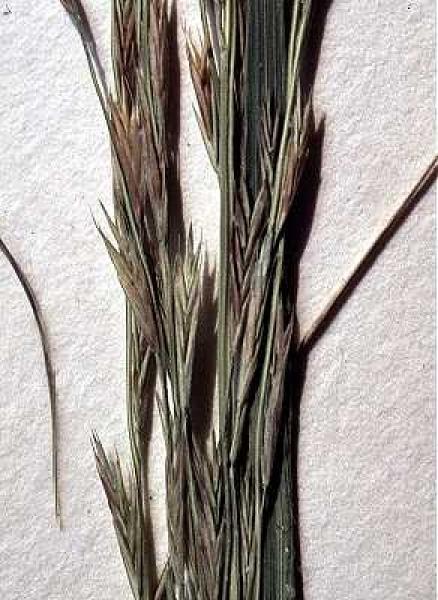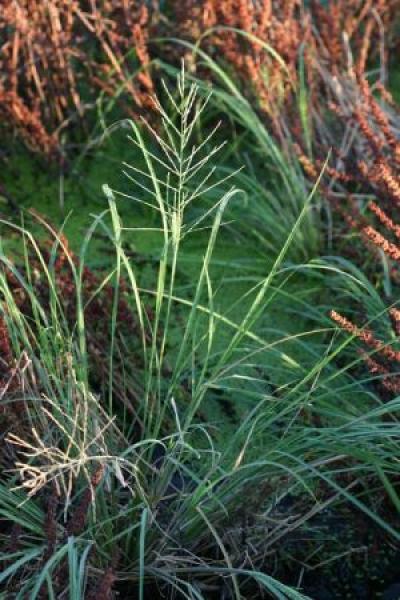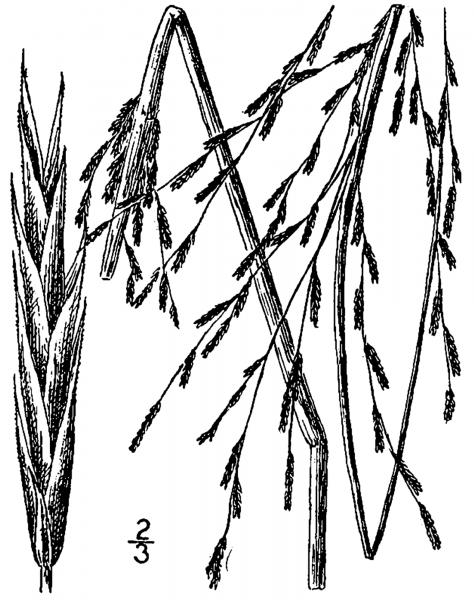Salt-meadow Grass
Diplachne fusca ssp. fascicularis (Lam.) P.M. Peterson & N. Snow
- Class
- Monocotyledoneae (Monocots)
- Family
- Poaceae (Grass Family)
- State Protection
- Endangered
Listed as Endangered by New York State: in imminent danger of extirpation in New York. For animals, taking, importation, transportation, or possession is prohibited, except under license or permit. For plants, removal or damage without the consent of the landowner is prohibited.
- Federal Protection
- Not Listed
- State Conservation Status Rank
- S4
Apparently Secure in New York - Uncommon in New York but not rare; usually widespread, but may be rare in some parts of the state; possibly some cause for long-term concern due to declines or other factors.
- Global Conservation Status Rank
- G5T5
Secure globally - Both the species as a whole and the subspecies/variety are common in the world; widespread and abundant (but may be rare in some parts of its range).
Summary
Did you know?
This grass was formally put in the genus Diplachne (as Diplachne maritima, first described from Nantucket [Bicknell 1968]) but it was shown that the fruit characters that separated it from Leptochloa were not consistent (Snow 1998). The common name sprangletop comes from the word sprangle, meaning going in all directions, and refers to the orientation of the flowering branches in this genus.
State Ranking Justification
There are six existing populations in the natural areas but only one of them is large, with over 10,000 plants. The plan is now being seen commonly on roadsides in the New York City area and Syracuse area.
Long-term Trends
Long-term trends are apparently negative, with some populations lost to wetland destruction and the ongoing threat of Phragmites incursion into most current populations.
Conservation and Management
Threats
Populations are threatened by expansion of the invasive plants Phragmites and purple loosestrife. Some populations may be threatened by trampling.
Habitat
Habitat
In New York Leptochloa fusca ssp. fascicularis is known exclusively from open, saline or brackish wetlands, including interdunal swales, mudflats, salt ponds, and salt marshes (New York Natural Heritage Program 2011). Brackish sites (Gleason and Cronquist 1991). Brackish soils (Fernald 1970).
Associated Ecological Communities
- Brackish interdunal swales
(guide)
Temporarily tidally flooded temperate marshes in interdunal swales dominated by salt-tolerant graminoids. Individual swales occur as small patches positioned between fore-, primary and secondary dunes in a maritime dunes system, typically on barrier islands.
- Brackish intertidal mudflats*
(guide)
A sparsely vegetated community, characterized by low-growing, rosette-leaved aquatics. The community occurs on exposed intertidal mudflats where water salinity ranges from 0.5 to 18.0 ppt. This community is best developed where mudflats are nearly level so that broad expanses are exposed at low tide. The rosette-leaved aquatics are completely submerged at high tide, and they are usually coated with mud.
- Coastal salt pond*
(guide)
A community inhabiting marine shoreline lakes or ponds formed by sandspits that close off a lagoon or bay. The water typically averages brackish or slightly brackish over long periods of time, but may range rapidly from fresh to saline.
- Inland salt marsh
(guide)
A wetland that occurs on saline mudflats associated with inland salt springs. The mucky substrate is permanently saturated and seasonally flooded. Plant cover is sparse and the number of different kinds of plants is relatively low.
- Inland salt pond*
(guide)
The aquatic community of a small, spring-fed pond in which the water is salty from flowing through salt beds in the aquifer. These salt springs occur in central New York, and were once common around Onondaga Lake in Syracuse, and near Montezuma. Most of the springs have been exploited for the production of salt, and are very disturbed or completely destroyed.
- Marine dredge spoil shore*
The wetland community of a constructed, intertidal or subtidal, marine shore in which the substrate is composed of dredge spoils. This community has minimal vegetative cover and relatively low species diversity. Dredge spoil shores provide foraging habitat for terns, gulls, and several shorebirds.
- Marine intertidal mudflats
(guide)
A community of quiet waters, with substrates composed of silt or sand that is rich in organic matter and poorly drained at low tide. The substrate may be covered with algae.
* probable association but not confirmed.
Associated Species
- Agrostis stolonifera (creeping bent)
- Amaranthus pumilus (sea-beach amaranth, coast amaranth)
- Bolboschoenus maritimus ssp. paludosus (American salt marsh bulrush)
- Chenopodium rubrum
- Cyperus spp.
- Lindernia dubia
- Lotus corniculatus (common bird's-foot-trefoil)
- Phragmites australis ssp. australis
- Schoenoplectus
Range
New York State Distribution
This grass of brackish/saline environments is currently known from Long Island and the inland salt ponds and roadsides of central New York. There is also one historical record from Rockland County in the southern Hudson Valley.
Global Distribution
This grass occurs throughout the United States but is rare in the Northeast in New York, Massachusetts, and Connecticut. It is considered exotic in Michigan, Ontario, and Québec.
Identification Comments
General Description
Salt-meadow Grass is an annual species with prostrate stems up to 110 centimeters long, growing in circular clumps. The leaves are up to 3 millimeters wide, the uppermost ones sometimes longer than the panicles. Its infloresence is a panicle, with spreading branches usually partially enclosed within the tops of the leaf sheaths. The spikelets are 5 to 12 millimeters long. It has lance-shaped lemmas, either sharp-tipped or with an awn up to 3.5 mm long. The seeds are 0.8 to 2 mm long (FNA 2003).
Best Life Stage for Proper Identification
This grass is best identified when the plant has mature fruit.
Similar Species
Previously three Leptochloa taxa were recognized in New York (Mitchell 1985), separating two non-native subspecies from the native one. Subsequent work has lumped these taxa, and now Leptochloa fusca ssp. fascicularis is considered to be the only member of the genus in New York (NYFA 2010).
Best Time to See
Salt-meadow Grass flowers in early July, with the fruits persisting until the first frost.
- Flowering
- Fruiting
The time of year you would expect to find Salt-meadow Grass flowering and fruiting in New York.
Salt-meadow Grass Images
Taxonomy
Salt-meadow Grass
Diplachne fusca ssp. fascicularis (Lam.) P.M. Peterson & N. Snow
- Kingdom Plantae
- Phylum Anthophyta
- Class Monocotyledoneae
(Monocots)
- Order Cyperales
- Family Poaceae (Grass Family)
- Order Cyperales
- Class Monocotyledoneae
(Monocots)
- Phylum Anthophyta
Additional Common Names
- Sprangletop
Synonyms
- Diplachne maritima Bickn.
- Leptochloa fascicularis var. maritima (Bickn.) Gleason
- Leptochloa fusca ssp. fascicularis (Lam.) N. Snow
Additional Resources
Best Identification Reference
Flora of North America Editorial Committee. 2003. Flora of North America, North of Mexico. Volume 25. Magnoliophyta: Commelinidae (in part): Poaceae, part 2. Oxford University Press, New York. 783 pp.
Other References
Fernald, M.L. 1950. Gray's manual of botany. 8th edition. D. Van Nostrand, New York. 1632 pp.
Gleason, Henry A. 1952. The New Britton and Brown Illustrated Flora of the Northeastern United States and Canada.
Gleason, Henry A. and A. Cronquist. 1991. Manual of Vascular Plants of Northeastern United States and Adjacent Canada. The New York Botanical Garden, Bronx, New York. 910 pp.
Holmgren, Noel. 1998. The Illustrated Companion to Gleason and Cronquist's Manual. Illustrations of the Vascular Plants of Northeastern United States and Adjacent Canada. The New York Botanical Garden, Bronx, New York.
Mitchell, Richard S. 1985. Checklist of New York vascular plants. New York State Museum publication. Albany, NY.
Mitchell, Richard S. and Gordon C. Tucker. 1997. Revised Checklist of New York State Plants. Contributions to a Flora of New York State. Checklist IV. Bulletin No. 490. New York State Museum. Albany, NY. 400 pp.
New York Natural Heritage Program. 2010. Biotics database. New York Natural Heritage Program. New York State Department of Environmental Conservation. Albany, NY.
New York Natural Heritage Program. 2024. New York Natural Heritage Program Databases. Albany, NY.
Weldy, T. and D. Werier. 2010. New York flora atlas. [S.M. Landry, K.N. Campbell, and L.D. Mabe (original application development), Florida Center for Community Design and Research http://www.fccdr.usf.edu/. University of South Florida http://www.usf.edu/]. New York Flora Association http://newyork.plantatlas.usf.edu/, Albany, New York
Links
About This Guide
This guide was authored by: Stephen M. Young
Information for this guide was last updated on: September 6, 2012
Please cite this page as:
New York Natural Heritage Program. 2024.
Online Conservation Guide for
Diplachne fusca ssp. fascicularis.
Available from: https://guides.nynhp.org/salt-meadow-grass/.
Accessed July 26, 2024.


